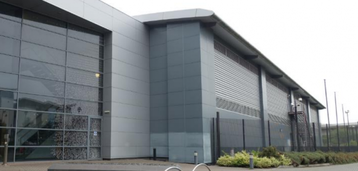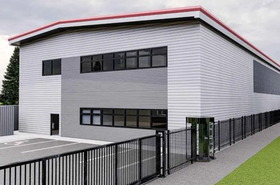Wales is well known for its industrial heritage, but coal mines, mills and factories no longer dominate its landscape. This abundance of disused land has, however, made way for a new type of industrial building: data centers.
South Wales, in particular, is home to a vibrant, fast-growing data center scene. This includes one of Europe’s largest data centers, Vantage’s CWL1 campus, pictured above. Located between Cardiff and Newport, the site sits on a 46-acre plot of land leased from the Welsh Government and boasts two operational data centers with another on the way.
Powered entirely by renewable energy sources, the facility offers 148MW of power across private halls and small racks. Other features include a 400kV UK SuperGrid direct connection; 10GE, nx10GE, 40GE and 100GE connectivity; a choice of 23 global connectivity providers; 24/7 on-site security; dedicated offices, co-working spaces and meeting rooms; backup generators and UPS systems; as well as N+1/N+20 percent cooling.
In another win for the Welsh data center scene, Vantage is planning to open a second Wales-based site in Bridgend. Having purchased Ford’s former Bridgend car engine plant in 2024, the hyperscaler reportedly wants to turn the land into ten buildings and three substations as part of a “multi-billion-pound” investment package.
Bridgend already houses a state-of-the-art data center facility operated by Canadian multinational IT consulting firm CGI. Located at Waterton Industrial Estate, the site provides British-hosted connectivity to CGI’s global customer base, operates on 100 percent renewable energy and has one of Wales’ largest commercial solar panel systems installed on its roof. Matt Reid, vice president of consulting delivery at CGI, tells DCD: “Wales offers a strategic location, strong potential for sustainable development, and the ability to retain national control over data governance.”
The rise of the Silicon Valleys
CGI did operate a second Bridgend data center, located at Bridgend Science Park. But it was eventually acquired by Proximity Data Centers and is now operated by nLighten, which took over Proximity in September 2023. The edge data center offers between 15 kW and 20 kW of power on raised and concrete floors in addition to N+1 power redundancy, N+1 cooling generation, N+1 air conditioning and carrier neutrality. Bridgend is an ideal Welsh data center location due to its close proximity to the M4 motorway, which provides a direct route to London, and the fact that it sits between Cardiff and Swansea.
Microsoft has also given Wales its stamp of approval. The American firm is currently building two large data centers on a former Quinn Radiators factory at Imperial Park in Newport. The development, which received planning permission in 2024, will generate an estimated 120 jobs for the local economy and forms part of a wider £2.5 billion investment package by the American tech firm into UK-based AI data centers.
Sarah Jones, chief marketing officer of industry body FinTech Wales, says inward investment from the likes of Vantage and Microsoft will “place Wales at the centre of the UK’s AI future”. She adds: “With advanced data centers on our doorstep, Wales is now equipped with the computing power needed to drive real innovation – from cutting-edge fintech solutions to AI in healthcare and beyond.”
It seems that the UK government agrees on the strategic importance of Wales when it comes to data center growth. In its Compute Roadmap, published this week, the Department of Science, Innovation, and Technology said Wales would host at least one AI Growth Zone, designated areas being set up for data center developments. Precise locations of the growth zones will be revealed later this year.
Mark John, founder of co-working space provider Tramshed Tech, expects to see the Welsh data center scene grow exponentially in light of the growth zone scheme. He says: “This would mark Wales out as a leader in data growth across the UK and Europe.”
North Wales, too, has a data center presence in the form of Iomart DC8 in St Asaph. Operating on 415 volts of power, the 130-square-metre, tier-two data center caters to the high-performance computing needs of businesses based in the region and further afield. It also offers a 165kVA generator, an 80kVA UPS, N+1 redundant air conditioning, diverse fibre routing, connectivity from BT and FibreSpeed, as well as round-the-clock monitoring and support.
While a lot smaller than the data center scene in the south, North Wales is set to get a £1 billion data center campus that could result in 2,000 new jobs for the region. Anglesey Land Holding, a subsidiary of ferry company Stena, is building the campus on an old aluminium plant in Anglesey. As per plans from its planning contractor, Cadnant Planning, the site will comprise a 238,000 sqm data center and a 349MW Battery Energy Storage Systems facility.
A digital revolution for all of Wales
As Wales navigates a post-industrial world, data centers are becoming an important focus for the Welsh Government. It views them as a major economic driver for all of Wales and, as such, has been working closely with hyperscale providers like Vantage to encourage them to establish Welsh operations and is supporting them in doing so.
A Welsh Government spokesperson said politicians in the nation view data centers as “a hub of growth” that accelerates research and development and innovation in the already-booming Welsh digital sector. And they believe that by building them in all parts of Wales, all communities can benefit from increased investment and new job opportunities at a time of high levels of unemployment. The spokesperson adds that data centers are also a “catalyst” for future generations, providing education opportunities like apprenticeships and skills programmes.
In addition to big economic benefits, introducing data centers to Wales also gives a new lease of life to “de-industrialised land”, says the spokesperson. In turn, this is “increasing localised connectivity” and “supporting the development” of Welsh renewable energy sources, setting up Wales for success in the digital era.
Wales is the perfect location for running a data center due to the “rare” combination of “space, connectivity and sustainability” it offers, according to Justin Leese, chief technology and operations officer of Welsh broadband provider Ogi.
Leese says data center companies are reimagining Wales’ large volume of brownfield sites for a new era by turning them into digital hubs. “That means data centers can tap into existing land and grid assets, without building from scratch,” he explains.
And thanks to “affordable land, expanding fibre and renewable energy”, Leese is confident that Wales can “lead the next phase of digital infrastructure” in Britain — especially when it comes to AI, edge computing and diaster recovery — and offer businesses “green, scalable alternatives to the southeast of England or Dublin”.
Challenges to overcome
Although Wales ticks myriad boxes for effective data center development, notable challenges exist. For Leese, the biggest are “power availability, planning timelines and regional skills gap”, all of which “slow things down”. He says: “Historically, some sites have struggled to get the right energy mix or network redundancy.”
Overcoming these hurdles requires grid operators, councils, investors and infrastructure operators to work closely together to “match sites with the right infrastructure from day one”, Leese says. In particular, he recommends building data centers in regions of Wales with no shortage of wind farms, hydro power and other renewable energy sources. For example, the biggest onshore wind farm in England and Wales is Pen y Cymoedd in Treorchy, South Wales. He adds: “It’s about being more deliberate – choosing locations that align with long-term sustainability and connectivity goals, not just short-term cost.”
CGI’s Reid says that when building data centers in “less urbanized areas” like Wales, common issues are “connectivity and resource scalability”. But he says the company has overcome these problems through “highly resilient infrastructure, advanced cooling technologies and strong local partnerships”. He adds: “The challenge isn’t choosing between innovation and sovereignty, it’s achieving both.”
Data centers in other parts of the UK
Outside of Wales, data centers are also driving economic progress in Britain’s two other devolved nations. Scotland has long been talked about as a promising data center hub, but has yet to make good on that promise. It already has 16 locations, according to statistics from Datacenters.com.
In Edinburgh, digital infrastructure provider Pulsant runs three of its fourteen edge data centers. Its chief operation officer, Ben Cranham, says Scotland is an “increasingly attractive” data center location owing to its generous array of renewable energy sources, the Scottish Government’s continued investment in the nation’s digital infrastructure, a strong and growing talent base and, of course, a cold climate.
Scotland could outpace Wales and southern parts of the UK for data center development over the coming years, too. Cranham explains that because so many data centers already exist along the M4 corridor and are putting pressure on local energy sources, the area is “reaching saturation” and proving to be a “serious constraint” for data center companies. Scotland, on the other hand, has “strong renewable energy potential, growing digital infrastructure and increasing regional investment”.
Despite offering many advantages for data center operators, Scotland poses some challenges that could stall industry growth if left unaddressed. Namely, Cranham says Edinburgh is far from London, making it logistically challenging to provide and maintain high-speed internet services between the north and south.
This sentiment is echoed by Stewart Laing, CEO of Asanti Data Centres, who says “a lack of sufficient fibre infrastructure” in northern Scotland and a “lack of commercial subsea connectivity” are significant constraints for data center operators based in the region.
According to Laing, Scotland’s data center industry is also being held back by “a lack of investment” from the government and private sector. He attributes this to “a limited understanding of the scale and opportunity within Scotland’s data center market”. He adds: “We’ve seen the Scottish National Investment Bank, for instance, move away from supporting digital infrastructure and focus solely on renewables.”
Scotland’s environmental red tape also makes it harder to build on greenfield land, but reports suggest that Scottish politicians may ease these rules to attract more data center developers. Whatever the case, operators like Pulsant have avoided this by building on brownfield sites instead.
And while Scotland is famed for its growing reliance on renewable energy, Cranham says fully utilizing the existing, under-pressure electricity grid introduces “inefficiencies and curtailment” for data center operators.
“Moreover, the UK’s single wholesale electricity market means energy costs are not necessarily lower in Scotland, and in fact, Scottish generators face higher transmission charges due to their distance from major demand centers in the South,” he adds.
Negatives aside, Scotland’s devolved government seems committed to tackling these issues as it looks to build a strong, resilient and sustainable digital economy fueled by home-based data centers. Amanda Brock, CEO of not-for-profit OpenUK, explains: “It has made a long-term commitment to data centers matched with its support for sustainability. The Scottish Government hosted COP26 in 2022 and also issued its Green Data Centers and Digital Connectivity Vision and Action Plan that year.”
Northern Ireland, despite having far fewer data centers than Wales and Scotland, also offers great potential for data center development. According to Data Center Map, the region has five facilities. But this could increase in the future due to the Windsor Framework, a legal arrangement between the UK and the European Union that aims to ensure the smooth transfer of goods between Great Britain and Northern Ireland.
Through this agreement, Northern Ireland remains in the EU Single Market for goods, though the UK government has veto power under the Stormont Brake. Seamus McCory, country manager for Ireland at cybersecurity firm Check Point Software, explains that it gives Northern Ireland “rare dual-market access to both the UK and EU”. He believes it is “a strategic advantage for global data operations”.
Northern Ireland is also the closest part of the UK to North America, which McCory says data center providers can leverage for “latency-sensitive sectors like financial trading”. Like the rest of the UK, Northern Ireland also has a cool climate, a fast-expanding pool of renewable energy resources and plenty of talent coming from top education institutions like Queen’s University Belfast.
Although Northern Ireland shares a border with one of Europe’s biggest data center markets, the Republic of Ireland, McCory says the latter’s “planning and energy supply constraints” could prove to be a unique opportunity for the industry in Northern Ireland.
“It offers access to EU markets through the Windsor Framework, lower land and operating costs, and available grid capacity, particularly in areas that are not yet saturated but remain close to key infrastructure,” he says.
What’s clear is that there’s strong momentum in the data center scenes of all three devolved nations. To maintain this, Marc Strathie — senior policy advisor for the devolved nations at industry body The Institute of Directors, says “planning reform” and “improved energy grid access” are needed.
He concludes: “The development of data centers must take local communities on the long-term journey to ensure they fully benefit from the positive societal and economic opportunities that new developments can deliver.”
More in Construction & Site Selection
Read the orginal article: https://www.datacenterdynamics.com/en/analysis/silicon-valleys-how-wales-became-a-data-center-hub/










